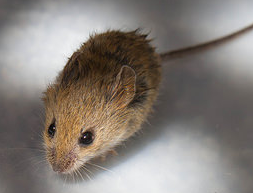Mice Will Hoard Food in Wall Voids
By Chris Williams on August 11, 2015.
We’re in the process of turning our garage into a family room. When I opened up a wall, I found a huge pile of what looks like moldy dog food stuffed into the wall void. Have you ever heard of this? I assume it’s from some animal but I don’t know what could get into that space.
E. L., Melrose, MA

I’ve definitely heard of this; our technicians see it all the time. It’s a pretty common occurrence when you combine a mouse problem with available pet food or birdseed. Mice like to collect and hoard food, sometimes referred to as “cached” food. When there is food competition, mice will store food near their nest so they can eat it in a protected location.
Mice will establish food caches usually within 10 feet of their nest (that can be 10 feet above or below, too). Rodent-hoarded food can be found behind the kick plate under the sink, or in a kitchen wall void, inside furniture, appliances, and even in the void space under the bathtub. If you have dog food routinely stored in the garage, and not in a mouse-proof container, you probably have mice nesting near that dog food supply (see Do Mice Eat Dry Pet Food?).
It’s not just mice that will cache food. Rats and squirrels will hoard food as well. Squirrels usually establish food caches in an attic, often more food than they could ever eat. One pest control professional found 30 pounds of dog food that had been hoarded by pine squirrels in the attic of a heated garage.
Cached Food Can Result in an Insect Infestation
Besides the mess, the cached food often results in an insect infestation. Indian meal moths and various food beetles will find and feed on this hidden food (see Food Moths Can Be Traced to a Rodent Infestation). And if the hoarded food gets damp and moldy, a whole new group of fungus-related beetles, flies, and mites can move in. A mouse’s food hoard can accumulate over many months and can result in hundreds of insects finding their way out of the hoarded food and into living space. When we can’t find the source of an ongoing food pest problem in a home, we always consider rodent-hoarded food.
First thing to do is get that dog food into a metal container with a tight-fitting lid. Dispose of the hoarded food in a sealed plastic bag in case it contains insects. Next thing to do is contact an exterminator for a mouse inspection of your home, followed by rodent control measures. That wall void may need to be treated, as well.